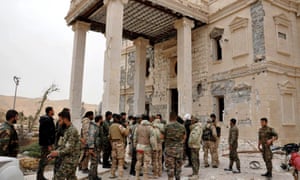
Palmyra’s famous temples will rise again from the desert sands, Syria’s top archaeologist has promised, as he prepared to inspect how much of the ancient city survived or can be salvaged from the ravages of Islamic State.
“We will not leave the temples destroyed,” Maamoun Abdelkarim, Syria’s director of antiquities, said, as Syrian government troops came closer to retaking one of the most spectacular ancient sites in the world from Isis.
The advancing soldiers were issued with warnings to watch out for booby-traps that could cause more damage to the site, he said, and archaeologists would follow in their wake to start the painstaking work of reconstructing the buildings from the rubble.
“We will assess how much damage the stones suffered and we will re-use them in order to scientifically put back the temples,” Abdelkarim said in a phone interview from Damascus, promising a blueprint for reconstruction by next month. “We have the plans and the images and we will rebuild the missing portions until the temples of Bel and Baalshamin are rebuilt.”
Isis blew up many of the citadel’s most revered buildings and murdered 82-year-old Khaled al-Asaad, the senior scholar who had preserved and studied the city all his life, when they swept into Palmyra last May. The videotaped destruction caused archaeologists around the world to despair. The scale of the damage could have been worse – the ancient city was wealthy and its vast structures were well built, meaning that large amounts of explosives – and labour – were needed to bring them down.
“The site is large, and systematic destruction of all of it would be an immense task,” said Kevin Butcher, professor of classics and ancient history at the University of Warwick. “It looks as if the most iconic buildings were targeted – the arch, the best-preserved temples and the big tower tombs.”
The destruction of Afghanistan’s giant Buddha statues by the Taliban in 2001 underlined the effort needed for large-scale devastation. It was only achieved after a team of two dozen prisoners were forced to spend days lacing the sculptures with explosives, because firing at them with anti-aircraft guns and artillery had little impact.
No comments:
Post a Comment